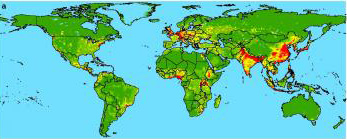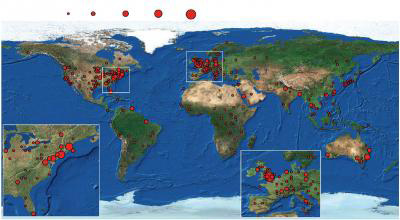Deforestation, wildlife conflict will be the source of emerging diseases
Deforestation, wildlife conflict will be the source of emerging diseases
mongabay.com
February 22, 2008
|
|
Due to habitat destruction and human-wildlife conflict, the tropics will likely be the next hotspot for emerging infectious diseases, report researchers who have developed the first map of new pathogens.
The results — based on correlation of 335 emerging diseases from 1940 to 2004 to maps showing human population density, population changes, latitude, rainfall and wildlife biodiversity — are published in the journal Nature. The authors showed that disease outbreaks have roughly quadrupled over the past 50 years, with 60 percent of “disease emergencies” originating in animals and traveling to humans. Most of these “zoonotic” diseases came from wild animals, suggesting that increased fragmentation and destruction will bring humans in contact will more pathogens, especially in biodiverse regions like the tropics.
“We are crowding wildlife into ever-smaller areas, and human population is increasing,” said coauthor Marc Levy of the Center for International Earth Science Information Network (CIESIN), an affiliate of Columbia University’s Earth Institute. “The meeting of these two things is a recipe for something crossing over.”
 Zoonotic pathogens passed from wildlife to people, from lowest occurrence (green) to highest (red). Credit: Jones et. al., Nature |
“Emerging disease hotspots are more common in areas rich in wildlife, so protecting these regions from development may have added value in preventing future disease emergence,” said coauthor Kate Jones, Senior Research Fellow of the Institute of Zoology. “It turns out that conservation may be an important means of preventing new diseases.”
Emerging diseases — including HIV-AIDS, SARS, and new strains of influenza — have caused hundreds of billions in damages worldwide. Now with multidrug-resistant strains of previously known pathogens like tuberculosis, Staphylococcus, and E. coli multiplying due to misuse of antibiotics in richer countries, the risk to human health from infectious disease is growing: drug-resistant strains accounted for 20 percent of disease emergencies from 1940-2004.
Monitoring hotspots hampered by lack of funding
The researchers say that despite the importance of the tropics as a hotbed for new disease, adequate funds have not been allocated for monitoring and researching emerging pathogens in the region.
 Global richness map of the geographic origins of EID events from 1940 to 2004. The map is derived for EID events caused by all pathogen types. Circles represent one degree grid cells, and the area of the circle is proportional to the number of events in the cell. Credit: Jones et. al., Nature |
“The world’s public-health resources are misallocated,” said lead author Peter Daszak, executive director of the Consortium for Conservation Medicine. “Most are focused on richer countries that can afford surveillance, but most of the hotspots are in developing countries. If you look at the high-impact diseases of the future, we’re missing the point.”
“We need to start finding pathogens before they emerge,” he continued. “Our priority should be to set up ‘smart surveillance’ measures in these hotspots… if we continue to ignore this important preventative measure then human populations will continue to be at risk from pandemic diseases.”
Jones, K. E. et al. Global Trends in Emerging Infectious Diseases. Nature 451, 990-993 (2008).